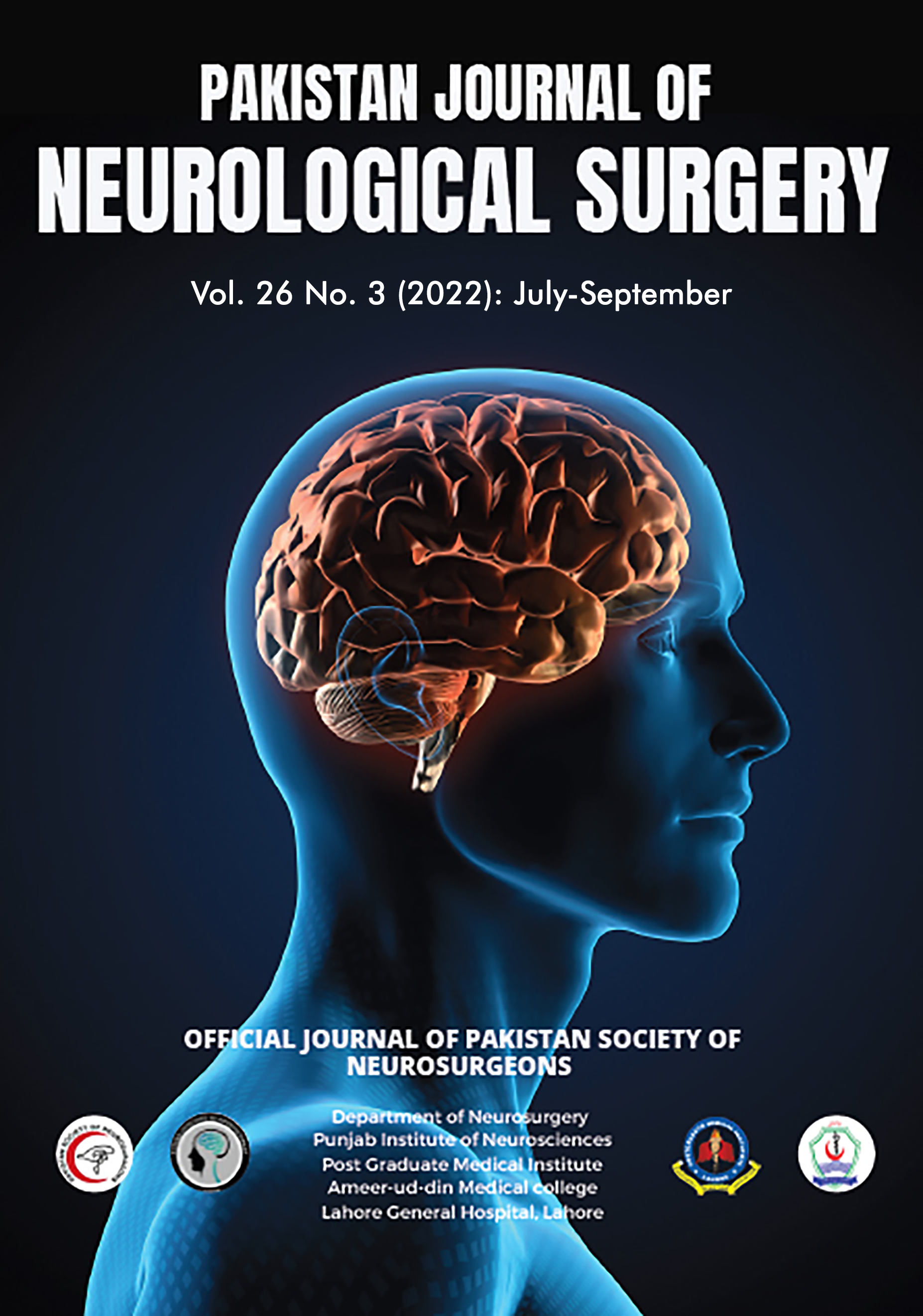Comparison of Cerebrospinal Fluid Leakage in Endoscopic Endonasal Transsphenoidal Surgery for Pituitary Adenoma with and without Sellar Floor Reconstruction
DOI:
https://doi.org/10.36552/pjns.v26i3.763Keywords:
Pituitary Adenoma, Endoscopic Endonasal Transsphenoidal Surgery, Cerebrospinal Fluid LeakageAbstract
Objectives: This study aimed to compare CSF leak in endoscopic endonasal TSS of pituitary adenoma with and without reconstruction of the sellar floor with no intraoperative CSF leakage.
Materials and Methods: It was a randomized controlled trial of 116 patients of both genders diagnosed case of pituitary adenoma who underwent endoscopic endonasal TSS over 1 year. The cases were randomized into 2 groups. In Group A endoscopic endonasal TSS and the sellar floor, reconstruction was done while in Group B only endoscopic endonasal transsphenoidal surgery was done without reconstruction.
Results: The patient’s mean age in group A was 40.7 ± 9.56 years, and in group, B was 41.9 ± 10.5 years. The gender distribution, for group A, males and females were 29 each (50%) and in group B, the males were 36 (62%) and females were 22 (38%). There were 52 (89.7%) cases of macroadenoma and 6 (10.3%) cases of microadenoma in each group. On the 1st postoperative day, CSF leakage was noted in 2 (3.4%) patients of group A, and CSF leakage was observed in 2 (3.4%) patients of group B. Results revealed no difference in CSF leakage between both groups. There were minor nasal complications in both groups.
Conclusion: There is an equal chance of success with endoscopic endonasal transsphenoidal surgery (TSS) of pituitary adenoma with and without reconstruction of the sellar floor, concerning post-operative CSF leak, in patients who have no intraoperative CSF leak which enlarges the pool of options for treatment.
References
Ostrom QT, Gittleman H, Fulop J, Liu M, Blanda R, Kromer C, et al. CBTRUS statistical report: primary brain and central nervous system tumors diagnosed in the United States in 2008-2012. Neuro-oncology. 2015;17(suppl_4):iv1-iv62.
McCoul ED, Bedrosian JC, Akselrod O, Anand VK, Schwartz TH. Preservation of multidimensional quality of life after endoscopic pituitary adenoma resection. Journal of neurosurgery. 2015;123(3):813-20.
Fernandez A, Karavitaki N, Wass JA. Prevalence of pituitary adenomas: a community?based, cross?sectional study in Banbury (Oxfordshire, UK). Clinical endocrinology. 2010;72(3):377-82.
Halvorsen H, Ramm-Pettersen J, Josefsen R, Rønning P, Reinlie S, Meling T, et al. Surgical complications after transsphenoidal microscopic and endoscopic surgery for pituitary adenoma: a consecutive series of 506 procedures. Acta neurochirurgica. 2014;156(3):441-9.
Barger J, Siow M, Kader M, Phillips K, Fatterpekar G, Kleinberg D, et al. The posterior nasoseptal flap: A novel technique for closure after endoscopic transsphenoidal resection of pituitary adenomas. Surgical Neurology International. 2018;9.
Karamouzis I, Caputo M, Mele C, Nuzzo A, Zavattaro M, Car P, et al. Transsphenoidal surgery for pituitary adenomas: early results from a single center. Hormones. 2018;17(4):551-6.
Strickland BA, Lucas J, Harris B, Kulubya E, Bakhsheshian J, Liu C, et al. Identification and repair of intraoperative cerebrospinal fluid leaks in endonasal transsphenoidal pituitary surgery: surgical experience in a series of 1002 patients. Journal of Neurosurgery. 2017;129(2):425-9.
Fan Y-p, Lv M-h, Feng S-y, Fan X, Hong H-y, Wen W-p, et al. Full endoscopic transsphenoidal surgery for pituitary adenoma-emphasized on surgical skill of otolaryngologist. Indian Journal of Otolaryngology and Head & Neck Surgery. 2014;66(1):334-40.
Cong Z, Liu K, Wen G, Qiao L, Wang H, Ma C. Universal sellar anatomical reconstruction using the sellar floor flap after endoscopic pituitary adenoma surgery. Otolaryngology–Head and Neck Surgery. 2018;158(4):774-6.
Roca E, Penn DL, Safain MG, Burke WT, Castlen JP, Laws Jr ER. Abdominal fat graft for sellar reconstruction: retrospective outcomes review and technical note. Operative Neurosurgery. 2019;16(6):667-74.
Sonnenburg RE, White D, Ewend MG, Senior B. Sellar reconstruction: is it necessary? American journal of rhinology. 2003;17(6):343-6.
Chang EF, Zada G, Kim S, Lamborn KR, Quinones-Hinojosa A, Tyrrell JB, et al. Long-term recurrence and mortality after surgery and adjuvant radiotherapy for nonfunctional pituitary adenomas. Journal of neurosurgery. 2008;108(4):736-45.
Gondim JA, Almeida JPC, Albuquerque LAF, Schops M, Gomes E, Ferraz T, et al. Endoscopic endonasal approach for pituitary adenoma: surgical complications in 301 patients. Pituitary. 2011;14(2):174-83.
Nishioka H, Izawa H, Ikeda Y, Namatame H, Fukami S, Haraoka J. Dural suturing for repair of cerebrospinal fluid leak in transnasal transsphenoidal surgery. Acta neurochirurgica. 2009;151(11):1427-30.
Cho JM, Ahn JY, Chang JH, Kim SH. Prevention of cerebrospinal fluid rhinorrhea after transsphenoidal surgery by collagen fleece coated with fibrin sealant without autologous tissue graft or postoperative lumbar drainage. Operative Neurosurgery. 2011;68(suppl_1):ons130-ons7.
Cappabianca P, Cavallo LM, Esposito F, Valente V, De Divitiis E. Sellar repair in endoscopic endonasal transsphenoidal surgery: results of 170 cases. Neurosurgery. 2002;51(6):1365-72.
Ismail M, Abdelhak B, D’Haens J, Michel O. Sellar reconstruction without intrasellar packing after endoscopic surgery of pituitary macroadenomas is better than its reputation. GMS German Medical Science. 2016;14.
Downloads
Published
Issue
Section
License
Copyright (c) 2022 Pakistan Journal Of Neurological Surgery

This work is licensed under a Creative Commons Attribution-NonCommercial 4.0 International License.
The work published by PJNS is licensed under a Creative Commons Attribution-NonCommercial 4.0 International (CC BY-NC 4.0). Copyrights on any open access article published by Pakistan Journal of Neurological Surgery are retained by the author(s).













